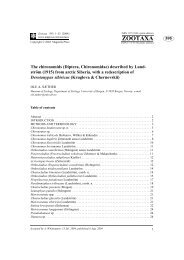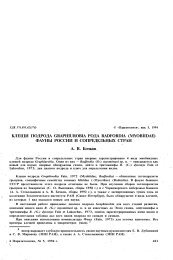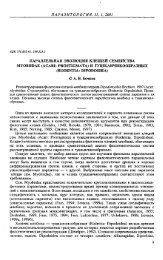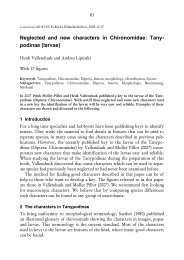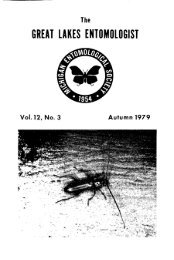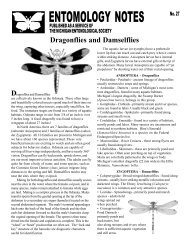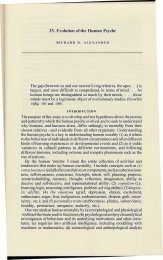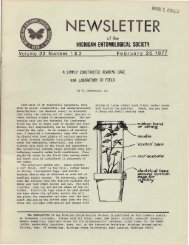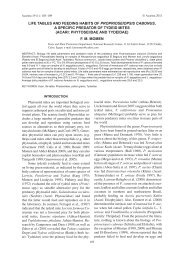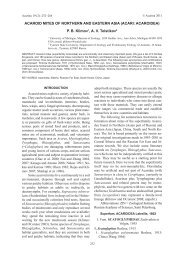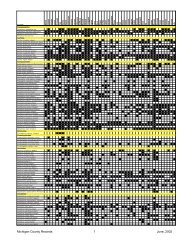Description of imago, pupal exuviae and larva of Chiro- nomus ...
Description of imago, pupal exuviae and larva of Chiro- nomus ...
Description of imago, pupal exuviae and larva of Chiro- nomus ...
You also want an ePaper? Increase the reach of your titles
YUMPU automatically turns print PDFs into web optimized ePapers that Google loves.
73<br />
Lauterbornia 70: 73-89, D-86424 Dinkelscherben, 2010-12-06<br />
<strong>Description</strong> <strong>of</strong> <strong>imago</strong>, <strong>pupal</strong> <strong>exuviae</strong> <strong>and</strong> <strong>larva</strong> <strong>of</strong> <strong>Chiro</strong><strong>nomus</strong><br />
uliginosus <strong>and</strong> a provisional key to the <strong>larva</strong>e <strong>of</strong><br />
the <strong>Chiro</strong><strong>nomus</strong> luridus agg. (Diptera: <strong>Chiro</strong>nomidae)<br />
Henk J. Vallenduuk <strong>and</strong> Peter H. Langton<br />
With 32 figures <strong>and</strong> 2 tables<br />
Keywords: <strong>Chiro</strong><strong>nomus</strong>, Lobochiro<strong>nomus</strong>, <strong>Chiro</strong>nomidae, Diptera, Insecta, The Netherl<strong>and</strong>s, Germany,<br />
morphology, nomenclature, identification, <strong>larva</strong>, pupa, exuvia, male<br />
Schlagwörter: <strong>Chiro</strong><strong>nomus</strong>, Lobochiro<strong>nomus</strong>, <strong>Chiro</strong>nomidae, Diptera, Insecta, Niederl<strong>and</strong>e, Deutschl<strong>and</strong>,<br />
Morphologie, Nomenklatur, Bestimmung, Larve, Puppe, Exuvie, Männchen<br />
The male <strong>imago</strong>, <strong>pupal</strong> <strong>exuviae</strong> <strong>and</strong> <strong>larva</strong> are described. The <strong>larva</strong>e <strong>of</strong> five species, four belonging<br />
to the <strong>Chiro</strong><strong>nomus</strong> luridus agg. <strong>and</strong> one belonging to the subgenus Lobochiro<strong>nomus</strong>,<br />
can be identified using a provisional key.<br />
1 <strong>Chiro</strong><strong>nomus</strong> uliginosus Keyl, 1960<br />
1.1 Introduction<br />
The morphologies <strong>of</strong> the <strong>pupal</strong> <strong>exuviae</strong> <strong>and</strong> the <strong>larva</strong> have not been described<br />
until now. The description <strong>of</strong> the male adult by Keyl (1960: 191), "Merkmale<br />
der Farbung und das Hypopygbaues stimmen mit denen von Ch. pseudothummi<br />
Str. überein.", has been insufficient to identify this species.<br />
Larvae <strong>of</strong> this species, identified as belonging to the <strong>Chiro</strong><strong>nomus</strong> luridus agg.<br />
(Vallenduuk, 1997, 2002) were first collected in 2006 by Gert Jan van Duinen<br />
in the nature reserve Bargerveen (The Netherl<strong>and</strong>s, Drenthe). Later Vallenduuk<br />
collected more <strong>larva</strong>e at other locations. Some <strong>larva</strong>e have been reared to<br />
adults <strong>and</strong> others have been cytologically identified by Pr<strong>of</strong>essor Dr. I.<br />
Kiknadze as being <strong>Chiro</strong><strong>nomus</strong> uliginosus Keyl. After studying the karyotype <strong>of</strong> <strong>larva</strong>e<br />
from different populations it was found that the Russian population <strong>of</strong> C.<br />
uliginosus might be a subspecies (Kiknadze et al., 2010: 29). This species occurs<br />
mainly in peaty water bodies. The Vallenduuk collected the <strong>larva</strong>e in the Netherl<strong>and</strong>s<br />
in nature reserves (Bargerveen, De Hamert, Duivelskuil, Peelvenen <strong>and</strong><br />
Mariapeel) <strong>and</strong> in nature reserves in Germany near Oldenburg (Stapeler Moor<br />
<strong>and</strong> Leegmoor).
74<br />
1.2 Morphology <strong>of</strong> the stages<br />
Larva<br />
The <strong>larva</strong> was collected in the "Pikmeeuwenwater" (De Hamert nature reserve,<br />
north <strong>of</strong> Arcen in the Netherl<strong>and</strong>s) on 18 May 2007. The <strong>larva</strong> is slide-mounted<br />
under the label chirulig1.<br />
Body (n=1)<br />
The <strong>larva</strong> belongs to the C. luridus agg.. Body length 12 mm. Lateral tubuli at<br />
segment VII <strong>and</strong> ventral tubuli at segment VIII present (Fig. 1). Posterior parapod<br />
with 16 unpigmented claws: 10 hooked claws in an outer circle <strong>and</strong> 6 more<br />
elongate claws in the middle.<br />
1 2<br />
Fig. 1-2: <strong>Chiro</strong><strong>nomus</strong>. uliginosus, <strong>larva</strong>. 1: Lateral tubuli at segment VII <strong>and</strong> ventral<br />
tubuli at segment VIII. 2: Antenna<br />
Head (for characters see Fig. 12-15):<br />
Head width 560 µm. LFa-Po 650 µm (“total” head length 680 µm). Unpigmented<br />
part <strong>of</strong> the postoccipital margin dorsally (Po-gap) 100 µm. IAsD 150 µm.<br />
Antennal socle width 100 µm. Antenna with 5 segments (Fig. 2). Segment 1<br />
length 142 µm, width 41 µm; segments 2-5 length 92 µm. The gula is unpigmented.<br />
The dark yellow frontal apotome has almost the same colour as the<br />
head. Labral sclerite 2 is present with an oval lens in the middle (Fig. 3). Labral<br />
sclerite 1 is absent. The clypeus is fused with the frontal apotome, its outer line<br />
protruding between the antennal socles. Pecten epipharyngis with relatively robust<br />
<strong>and</strong> pointed teeth (Fig. 4). Upper <strong>and</strong> lower prem<strong>and</strong>ibular teeth almost<br />
equal (Fig. 5). Dorsal m<strong>and</strong>ibular tooth (MdT) pale <strong>and</strong> three inner m<strong>and</strong>ibular<br />
teeth (Fig. 6-MiT). The third madibular tooth MiT3) is the smallest <strong>and</strong> is<br />
weakly pigmented. The mentum has sharply pointed teeth (Fig. 6). The central
75<br />
mental tooth C2 is partly fused with C1 to form a roughly triangular shape<br />
(Fig. 6). Lateral mental tooth L2 is fused along about half its length with L1.<br />
The top <strong>of</strong> the lateral mental tooth L4 lies on one line with teeth L3 <strong>and</strong> L5<br />
(Fig. 6). MS 58 µm. IPD 57 µm. VmP width 195 µm (Fig. 7). Str L1: 6. LC1-Po<br />
352 µm.<br />
3<br />
4 5<br />
6 7<br />
Fig. 3-7: <strong>Chiro</strong><strong>nomus</strong>. uliginosus, <strong>larva</strong>. 3: Labral sclerite 2. 4: Mentum <strong>and</strong> labrum with<br />
pecten epipharyngis. 5: Prem<strong>and</strong>ible. 6: Mentum <strong>and</strong> m<strong>and</strong>ible. 7: Ventromental plate
76<br />
Pupal <strong>exuviae</strong> <strong>and</strong> associated adult male<br />
Both mounted together on a slide marked <strong>Chiro</strong><strong>nomus</strong> uliginosus leg. H. Vallenduuk.<br />
Location: 06084-Bargerveen, Netherl<strong>and</strong>s. 16.viii.2007. Leg. H. Vallenduuk.<br />
Larva reared to adult. In 2007 <strong>and</strong> 2008 Vallenduuk collected <strong>larva</strong>e at four locations<br />
in the Bargerveen nature reserve. The <strong>larva</strong>e, belonging to the <strong>Chiro</strong><strong>nomus</strong><br />
luridus agg., were cytologically identified by Pr<strong>of</strong>essor dr. Iya Kiknadze as being<br />
<strong>Chiro</strong><strong>nomus</strong> uliginosus.<br />
Pupal <strong>exuviae</strong> (n=1)<br />
Medium sized pupae, 8.1 mm long. Exuviae pale brown, cephalothorax <strong>and</strong> lateral<br />
margins <strong>of</strong> abdominal tergites brown. Spur <strong>of</strong> segment VIII brown (Fig. 9).<br />
Anal lobes brown outwards to the insertion <strong>of</strong> the taeniae, then colourless.<br />
Cephalothorax.. Cephalic tubercles narrow conical, 84µm long, ending in<br />
frontal setae 48µm long (Fig. 8b). Thoracic horn richly branched, plumose.<br />
Basal ring <strong>of</strong> thoracic horn 132 x 68µm, tracheal patch 100 x 40µm about 15<br />
tracheoles across, 2µm diameter. Thorax granulation (Fig. 8a) well developed<br />
anteriorly, small granulate between dorsocentral setae <strong>and</strong> suture, smooth<br />
above the oblique hinge line <strong>and</strong> below the dorsocentral setae.<br />
8 9<br />
Fig. 8-9: <strong>Chiro</strong><strong>nomus</strong> uliginosus, <strong>pupal</strong> <strong>exuviae</strong>. 8: a = thorax dorsal, b = frontal<br />
apotome, c = spur <strong>of</strong> segment VIII, d = armament <strong>of</strong> mid tergite IV. 9: Segment VI-VIII<br />
Abdomen. Tergite I unarmed, II-V with median undivided patches <strong>of</strong> dense<br />
short points, showing little imbrication (Fig. 8d), larger posteriorly. On tergite<br />
VI the point patch narrows posteriad to about 10 points wide just anterior to<br />
setae D5.) Tergite VII with a transverse b<strong>and</strong> <strong>of</strong> small points anterior to setae
77<br />
D1, medially narrowed (Fig. 9). VIII with 2 lateral patches <strong>of</strong> small points, not<br />
arranged in rows. Anal segment without shagreen. Paratergites V <strong>and</strong> VI with a<br />
very narrow longitudinal b<strong>and</strong> <strong>of</strong> very small points. Pleura <strong>of</strong> segment IV unarmed.<br />
Ventral shagreen consisting <strong>of</strong> extremely small points, on II the lateral<br />
longitudinal b<strong>and</strong>s do not connect with the median patch posteriorly, on III<br />
the lateral b<strong>and</strong>s extend for much <strong>of</strong> the sternite length, on IV apparently absent.<br />
Hook row 0.38 segement breadth, with about 80 hooks. Vortex distinct<br />
on segment IV; conspicuous pedes spurii B present on segment II. Segment VIII<br />
with dark brown, strong postero-lateral spurs (Fig. 8c), each with with 1 sturdy<br />
apical tooth.<br />
Chaetotaxy <strong>of</strong> abdominal segments (one side)<br />
I II III IV V VI VII VIII IX<br />
Ds 2 4 5 5 5 5 5 1 1<br />
Ls 1 3 4 4<br />
Lt 4 4 4 5 90<br />
The <strong>pupal</strong> <strong>exuviae</strong> runs to <strong>Chiro</strong><strong>nomus</strong> (s.str.) Pe32 in Langton & Visser (2003), a<br />
form obtained from littoral wetl<strong>and</strong>s in southern Spain, but can be distinguished<br />
by the lack <strong>of</strong> granulation above the oblique hinge line <strong>and</strong> below the<br />
dorsocentral setae <strong>of</strong> the cephalothorax (in Pe32 the granulation is stronger <strong>and</strong><br />
much more extensive).<br />
Adult male (n=1)<br />
Colour (alcohol preserved): Head yellow, pedicellus dark brown, flagellum<br />
mid-brown, palpomeres 2-4 mid-brown, 1 <strong>and</strong> 5 yellow, eyes black. Thorax<br />
yellow, scutal stripes mid-brown, median scutal b<strong>and</strong> extending posteriad as far<br />
as the scutal tubercle, median anepisternum II <strong>and</strong> lower two thirds <strong>of</strong> preepisternum<br />
dark brown, halteres yellow, postnotum black except for a narrow<br />
yellow b<strong>and</strong> at base dorsally. Legs yellow with tips <strong>of</strong> tibiae <strong>and</strong> metatarsi, <strong>and</strong><br />
tarsomeres 3-5 brownish; combs <strong>of</strong> mid <strong>and</strong> posterior tibiae black. Wings unmarked.<br />
Abdominal tergites I-VI brown with posterior ¼ to ½ yellow, VII <strong>and</strong><br />
VIII brown; all sternites <strong>and</strong> pleura yellow; hypopygium dark brown, with<br />
projecting part <strong>of</strong> anal point black above.<br />
Antenna. Antenna with a large globular pedicel <strong>and</strong> flagellum <strong>of</strong> 11 flagellomeres<br />
2-10 1½ times as wide as long. Flagellum segment lengths: 80, 34, 32,<br />
36, 32, 32, 32, 32, 32, 32, 1180 µm. Antennal ratio (AR) 3.2.<br />
Head. Eye bare, with a long dorsomedial parallel-side extension, 230µm long,<br />
80µm broad. Verticals 19/25. Clypeals 24. Frontal tubercles 36µm long, 12µm<br />
broad. Palp 5 segmented, segment lengths: 72, 72, 276, 252, 400 µm.<br />
Thorax. Acrostrichals 13. 21 dorsocentral setae. 5 prealars. Scutellum with 8<br />
setae on the left side.
78<br />
Wing. Length (arculus to wingtip) 2.9mm. R with 36, 39 setae; R1 with 31 <strong>and</strong><br />
R4+5 38, 41. Squama with 17, 18 setae.<br />
Legs (length in µ m)<br />
Leg Fe Ti Ta1 Ta2 Ta3 Ta4 Ta5 LR BR<br />
1 1320 1120 1860 980 740 620 300 1.7 2.9<br />
2 1380 1300 800 460 320 200 160 0.6 3.0<br />
3 1560 1600 1140 660 500 300 200 0.7 4.7<br />
Abdomen. Tergites <strong>and</strong> sternites with dense irregularly distributed setae.<br />
Hypopygium. (Fig. 10) Central pale part <strong>of</strong> tergite IX with 11 very long setae.<br />
Anal point constricted basally <strong>and</strong> exp<strong>and</strong>ed in distal half. Superior volsella<br />
distally broad foot shaped (S-type, according to Strenzke, 1959). Inferior<br />
volsella covered with microtrichia, distal part with curved, long setae.<br />
Laterotergite IX with 5, 6 setae; gonocoxite with 29, 31 setae, Gonostylus narrowed<br />
subapically, with about 10 long setae; inner margin at tip with 5, 6 setae.<br />
The adult male runs to <strong>Chiro</strong><strong>nomus</strong> (C.)<br />
pseudothummi Strenzke in Langton & Pinder<br />
(2007), which it very closely resembles (as<br />
noted by Keyl (1960); the broader superior<br />
volsellae, fewer scutellar setae <strong>and</strong> longer<br />
dorsal setae <strong>of</strong> tergite IX may serve to identify<br />
it.<br />
Fig. 10: <strong>Chiro</strong><strong>nomus</strong> uliginosus, male. Hypopygium<br />
2 The <strong>larva</strong>e <strong>of</strong> the <strong>Chiro</strong><strong>nomus</strong> luridus agg.<br />
2.1 Introduction<br />
Identification <strong>of</strong> the species, belonging to the <strong>Chiro</strong><strong>nomus</strong> luridus agg., has not<br />
been possible until now. Webb <strong>and</strong> Scholl (1985) <strong>and</strong> Vallenduuk (1997, 2002)<br />
stated that three species belonging to this group were difficult to distinguish.<br />
Unfortunately the descriptions <strong>of</strong> the <strong>larva</strong>e given by Kiknadze (1991) were insufficient<br />
to identify the species. Larvae belonging to four species <strong>of</strong> the <strong>Chiro</strong><strong>nomus</strong><br />
luridus aggregate have been cytologically identified by Pr<strong>of</strong>essor Dr. I.<br />
Kiknadze, which enabled us to examine these four species.
79<br />
2.2 The <strong>larva</strong> <strong>of</strong> <strong>Chiro</strong><strong>nomus</strong> longipes Staeger<br />
Shilova (1980: 176-180) described the species Einfeldia longipes Staeger. She stated<br />
that antennal segment 3 is much shorter than segment 4, the length <strong>of</strong> antennal<br />
segment 1 <strong>and</strong> the total length <strong>of</strong> segments 2-5 are equal, <strong>and</strong> the lateral mental<br />
tooth L4 is smaller than the surrounding teeth (?L3 <strong>and</strong> L5). In our material we<br />
did not see these characters (see table). Unfortunately it was not possible to examine<br />
the <strong>larva</strong>e, which are described by Shilova.<br />
Spies <strong>and</strong> Sæther (2004: 38-40) stated that the correct name <strong>of</strong> <strong>Chiro</strong><strong>nomus</strong> longipes<br />
Staeger is <strong>Chiro</strong><strong>nomus</strong> Lobochiro<strong>nomus</strong> dorsalis Meigen. In 2010 Vallenduuk collected<br />
<strong>larva</strong>e <strong>of</strong> this species in Germany (Black Forest, near St. Peter). Some <strong>larva</strong>e<br />
were reared to adult. The <strong>pupal</strong> <strong>exuviae</strong> <strong>and</strong> <strong>imago</strong> were identified by Dr.<br />
P. Langton. The <strong>larva</strong>e <strong>of</strong> this species are morphologically very close to those<br />
<strong>of</strong> the <strong>Chiro</strong><strong>nomus</strong> luridus agg. (sibling species). Information about distribution,<br />
water type <strong>and</strong> autecology can be found in Moller Pillot (2009).<br />
Using this important material, Vallenduuk was able to find characters to<br />
identify the following five species:<br />
<strong>Chiro</strong><strong>nomus</strong> Lobochiro<strong>nomus</strong> Ryser, Wülker & Scholl, 1985<br />
dorsalis Meigen, 1818 (syn.: <strong>Chiro</strong><strong>nomus</strong> longipes Staeger, 1839)<br />
<strong>Chiro</strong><strong>nomus</strong> <strong>Chiro</strong><strong>nomus</strong> Meigen, 1803<br />
luridus Strenzke, 1959<br />
parathummi Keyl, 1961<br />
pseudothummi Strenzke, 1959<br />
uliginosus Keyl, 1960<br />
All five species have lateral tubuli at segment VII <strong>and</strong> two pairs <strong>of</strong> ventral tubuli<br />
at segment VIII (Fig. 1). They do not have pigmentation on the gula. However,<br />
C. pseudothummi may have a small patch <strong>of</strong> pigmentation medially <strong>and</strong> laterally<br />
close to the postoccipital margin.<br />
3 Provisional key to the <strong>larva</strong>e <strong>of</strong> <strong>Chiro</strong><strong>nomus</strong> luridus agg. <strong>and</strong><br />
<strong>Chiro</strong><strong>nomus</strong> Lobochiro<strong>nomus</strong> dorsalis<br />
With this key it will be possible to identify the <strong>larva</strong>e <strong>of</strong> four species <strong>of</strong> the<br />
<strong>Chiro</strong><strong>nomus</strong> s. str. luridus agg. <strong>and</strong> <strong>Chiro</strong><strong>nomus</strong> Lobochiro<strong>nomus</strong> dorsalis Meigen. The <strong>larva</strong>e<br />
<strong>of</strong> all five species are morphologically very close (sibling species). All species<br />
<strong>of</strong> the subgenus Lobochiro<strong>nomus</strong> probably have a pecten epipharyngis with irregular<br />
teeth (Epler, 2001: 8.42) <strong>and</strong> this character might be a feature that<br />
distinguishes the two subgenera (Fig. 28-32). The abbreviations used in the key<br />
are explained in table 1. The characters <strong>and</strong> measurements given in the key <strong>and</strong><br />
summarized in table 2 are based on examination <strong>of</strong> a small number <strong>of</strong> <strong>larva</strong>e.<br />
Note that the range <strong>of</strong> sizes, given in the key <strong>and</strong> the table, needs to be updated.<br />
The tables will be completed in a forthcoming key to all species <strong>of</strong> <strong>Chiro</strong><strong>nomus</strong>.
80<br />
The key is based on macroscopic characters (magnification up to 60x). Notice<br />
that misidentification is easy, especially when the user <strong>of</strong> the key does not have<br />
experience with identification <strong>of</strong> this group. When identifying the species for<br />
the first time we advise comparing measurements with the data given in the<br />
table.<br />
When examining <strong>larva</strong>e we recommend putting the <strong>larva</strong>e into a petri dish<br />
with 70 % alcohol. Many characters can be seen at 40 x magnification with illumination<br />
from above. Setae can be seen best with diascopic illumination. The<br />
lens in the labral sclerite Sl2 cannot always be distinguished well because the<br />
labrum is very elastic. Note that this character might be very variable. To examine<br />
its shape the labrum must be situated horizontally. Especially when<br />
making measurements the <strong>larva</strong> has to be placed in an exactly horizontal position.<br />
We advise that the <strong>larva</strong> is put on a slide next to a pile <strong>of</strong> two or three<br />
coverslips in a drop <strong>of</strong> alcohol. When covered by a coverslip (Fig. 11) the <strong>larva</strong><br />
can be rolled by moving the coverslip to the left or right with one fingertip <strong>and</strong><br />
will not be flattened.<br />
Fig. 11: Tanypodinae <strong>larva</strong>. Larva under a coverslip for rolling the <strong>larva</strong> into a good<br />
position<br />
If details <strong>of</strong> the head cannot be seen well, we recommend the addition <strong>of</strong> a drop<br />
<strong>of</strong> lactic acid next to the coverslip. The lactic acid will mix with the alcohol <strong>and</strong><br />
make the head transparent. We do not advise making a permanent slide, but if<br />
it is preferred it is advisable to attach a self-adhesive label the slide with the following<br />
identifying information: lateral tubuli on segment VII present or absent,<br />
pigmentation <strong>of</strong> the inner m<strong>and</strong>ibular teeth, pigmentation <strong>of</strong> the gula <strong>and</strong><br />
the LFA-Po.
81<br />
Tab. 1: Glossary <strong>of</strong> the abbreviations used in the key<br />
Term <strong>Description</strong> Figure<br />
As antenna, placed on an antennal socle 1, 14<br />
C1,2 central mental teeth C1,2 15<br />
FA frontal apotome 12<br />
FS suture <strong>of</strong> frontal apotome 14<br />
gula area between mentum <strong>and</strong> postoccipital margin (Po) 13<br />
IAsD distance between both antennal socles 12<br />
IPD distance between both ventromental plates 15<br />
L1-6 lateral mental teeth L1-6 13<br />
L2 index the distance taken from the incision between L2 <strong>and</strong> L1 to the incision 15<br />
between L2 <strong>and</strong> L3<br />
LC1-Po distance between central mental tooth C1 <strong>and</strong> postoccipital margin (Po) 13<br />
LFA-Po distance between frontal apotome <strong>and</strong> postoccipital margin (Po) 12<br />
MaT apical m<strong>and</strong>ibular tooth 15<br />
MdT dorsal m<strong>and</strong>ibular tooth 15<br />
MiT inner m<strong>and</strong>ibular teeth 15<br />
MS mental size, distance between the middle <strong>of</strong> both lateral mental teeth L1 15<br />
PE pecten epipharyngis 13, 15<br />
Po postoccipital margin 13, 14<br />
Po mark triangular form on the postoccipital margin laterally 14<br />
S9+10 seta 9 <strong>and</strong> 10 on the thead capsule laterally 14, 16<br />
Sl2 labral sclerite 2 12<br />
StrL1 number <strong>of</strong> striae taken over the width <strong>of</strong> lateral mental tooth L1 15<br />
VmP ventromental plate 7, 13
82<br />
1a Frontal apotome (FA) completely pigmented with a brownish colour<br />
(Fig. 12, 14) 4<br />
Note: Exceptionally an uliginosus <strong>larva</strong> has the FA weakly pigmented <strong>and</strong> the identification<br />
will run to luridus. In that case consult the table. Usually both species do not occur at the<br />
same site.<br />
b Frontal apotome (FA) unigmented. Head capsule completely yellow <strong>and</strong><br />
sometimes the FA somewhat darker yellow than the head capsule 2<br />
2a Distance S9+10 to the eye spot about half the eye-width or more (Fig.<br />
16). Postoccipital margin over its total length, except its gap, equally pigmented<br />
(Fig. 13, 14). Suture <strong>of</strong> the frontal apotome (FS) obvious. FS is<br />
shown as a pale line running from the antennal socle to the postoccipital<br />
margin (Fig. 12, 14) 3<br />
Note: Eyes can be displaced in the head. Examine both sides <strong>of</strong> the head.<br />
b Distance S9+10 to the eye spot less than half the eye-width (Fig. 17).<br />
Postoccipital margin over its total length, except its gap, not equally pigmented.<br />
Between the triangular marks (Po mark) more weakly pigmented.<br />
Suture <strong>of</strong> the frontal apotome (FS) faint or not visible. Head width<br />
maximum 510 µm 6<br />
Note: Eyes can be displaced in the head. Examine both sides <strong>of</strong> the head.<br />
12 13<br />
Fig. 12-13: <strong>Chiro</strong><strong>nomus</strong> luridus, <strong>larva</strong>. 12: Head dorsally. 13: Head ventrally
83<br />
Fig. 14: <strong>Chiro</strong><strong>nomus</strong> luridus, <strong>larva</strong>.<br />
Head laterally<br />
Fig. 15: <strong>Chiro</strong><strong>nomus</strong> luridus,<br />
<strong>larva</strong>. Labrum, mentum with<br />
ventromental plate; uliginosus,<br />
<strong>larva</strong>. M<strong>and</strong>ible<br />
16 17<br />
Fig. 16: <strong>Chiro</strong><strong>nomus</strong> parathummi, <strong>larva</strong>. S9+10 <strong>and</strong> eye spot Fig. 17: <strong>Chiro</strong><strong>nomus</strong><br />
Lobochiro<strong>nomus</strong> dorsalis, <strong>larva</strong>. S9+10 <strong>and</strong> eye spot
84<br />
3a Central mental tooth C2 along more than half its length fused with C1<br />
(Fig.18, 19) FA usually pigmented 4<br />
b Central mental tooth C2 fused along less than half its length with C1 to<br />
form a roughly triangular shape (Fig. 20, 21). FA unpigmented 5<br />
4a Frontal apotome (FA) completely pigmented with a contrasting brownish<br />
colour (Fig. 12, 14). Lateral mental tooth L2 fused along about half its<br />
length with L1; L2 index 8-10 µm (Fig. 15, 18). Lens in Sl2 short oval (Fig.<br />
22) luridus<br />
Note: Lens in Sl2 might be variable.<br />
b Frontal apotome (FA) can be pigmented with a weak brownish colour.<br />
Lateral mental tooth L2 fused over more than half its length with L1; L2<br />
index 12-15 µm (Fig. 19). Lens in Sl2 elongate oval, running parallel over<br />
almost the complete sclerite (Fig. 23) pseudothummi<br />
Note: Lens in Sl2 might be variable.<br />
5a Three inner m<strong>and</strong>ibular teeth. MiT1 <strong>and</strong> 2 dark; MiT3 weakly pigmented<br />
<strong>and</strong> smaller (Fig. 6, 15). The incision between the lateral mental teeth L1<br />
<strong>and</strong> L2 higher <strong>and</strong> not on one imaginary line with those <strong>of</strong> L3 to L6 (Fig.<br />
20). Head width (480)550-620 µm. LFA-Po 570-650 µm. Lens <strong>of</strong> Sl2 short<br />
oval (Fig. 24) uliginosus<br />
Note: Lens in Sl2 might be variable.<br />
b Two inner m<strong>and</strong>ibular teeth are visible. MiT3 seems to be absent (Fig.<br />
26). The incision between the lateral mental teeth L1 <strong>and</strong> L2 is almost in<br />
one imaginary line with those <strong>of</strong> L3 to L6 (Fig. 21). Head width 470-490<br />
µm. LFA-Po 500-550 µm. Lens in Sl2 more elongate oval (Fig. 25)<br />
parathummi<br />
Note: Lens in Sl2 might be variable.<br />
18 19<br />
Fig. 18: <strong>Chiro</strong><strong>nomus</strong> luridus, <strong>larva</strong>. Mentum. Fig. 19: <strong>Chiro</strong><strong>nomus</strong> pseudothummi,<br />
<strong>larva</strong>. Mentum
85<br />
20 21<br />
Fig. 20: <strong>Chiro</strong><strong>nomus</strong> uliginosus, <strong>larva</strong>. Mentum. Fig. 21: <strong>Chiro</strong><strong>nomus</strong> parathummi,<br />
<strong>larva</strong>. Mentum<br />
22 23<br />
Fig. 22: <strong>Chiro</strong><strong>nomus</strong> luridus, <strong>larva</strong>. Labral sclerite 2. Fig. 23: <strong>Chiro</strong><strong>nomus</strong> pseudothummi,<br />
<strong>larva</strong>. Labral sclerite 2<br />
24 25<br />
Fig. 24: <strong>Chiro</strong><strong>nomus</strong> uliginosus, <strong>larva</strong>. Labral sclerite 2. Fig. 25: <strong>Chiro</strong><strong>nomus</strong> parathummi,<br />
<strong>larva</strong>. Labral sclerite 2<br />
Fig. 26: <strong>Chiro</strong><strong>nomus</strong> parathummi, <strong>larva</strong>.<br />
M<strong>and</strong>ible
86<br />
6a Head width 410-450 µm. Teeth <strong>of</strong> pecten epipharyngis (PE) laterally with<br />
irregular shape: A very narrow <strong>and</strong> short tooth between broader teeth<br />
(Fig. 28). Third inner m<strong>and</strong>ibular tooth <strong>of</strong> m<strong>and</strong>ible (MiT3) hardly<br />
visible, it seems to be absent (Fig. 27)<br />
<strong>Chiro</strong><strong>nomus</strong> Lobochiro<strong>nomus</strong> dorsalis<br />
b Head width about 400 µm or smaller. Teeth <strong>of</strong> pecten epipharyngis (PE)<br />
laterally with regular shape (Fig. 29, 30, 31, 32) luridus agg., instar III<br />
27 28<br />
29 30<br />
31 32<br />
Fig. 27-28: <strong>Chiro</strong><strong>nomus</strong> Lobochiro<strong>nomus</strong> dorsalis, <strong>larva</strong>. 27: M<strong>and</strong>ible, prem<strong>and</strong>ible<br />
<strong>and</strong> pecten epipharyngis. 28: Pecten epipharyngis<br />
Fig. 29: <strong>Chiro</strong><strong>nomus</strong> luridus, <strong>larva</strong>. Pecten epipharyngis. 30: <strong>Chiro</strong><strong>nomus</strong> parathummi,<br />
<strong>larva</strong>. Pecten epipharyngis<br />
Fig. 31: <strong>Chiro</strong><strong>nomus</strong> pseudothummi, <strong>larva</strong>. Pecten epipharyngis.Fig. 32: <strong>Chiro</strong><strong>nomus</strong><br />
uliginosus, <strong>larva</strong>. Pecten epipharyngis
87<br />
Tab. 2: Measures <strong>and</strong> features <strong>of</strong> the species treated in the key. BL max = maximum<br />
length <strong>of</strong> the body, HW = head width, L1:L2-5 = length <strong>of</strong> segment 1 compared with<br />
the total length <strong>of</strong> segments 2 to 5; consult also the glossary<br />
Dorsally BL max LFA-Po HW FA Antenna<br />
mm µm µm colour L1 : L2-5<br />
pseudothummi 16 640–710 550–620 yellow–<br />
weak brown<br />
1,5–2<br />
luridus 12 600–710 510–620 brownish about 2<br />
uliginosus 12 570–710 (480)520–<br />
620<br />
yellow about 1.75<br />
parathummi 12 500–550 470–490 yellow about 1.5<br />
dorsalis 11,5 450-510 410–450 yellow about 1.2<br />
E. longipes<br />
(400–500) 390–480 equal<br />
(Shilova)<br />
total length<br />
Ventrally LC1-Po MS IPD MiT3 L2 Index<br />
µm µm µm<br />
pseudothummi 340–380 55–68 55–65 obvious 13–15<br />
luridus 320–348 58–60 50–62 obvious 8–10<br />
uliginosus 340–360 55–60 57–68 obvious 9–10<br />
parathummi 260–284 54–65 40–47 not obvious ± 8<br />
dorsalis<br />
E. longipes<br />
(Shilova)<br />
237–253 45–52 30–38 very small 7–10<br />
4 Request<br />
If you are unable to identify a species with certainty, please send an email with<br />
information about the problem to Henk Vallenduuk. This information will be<br />
very helpful in compiling the forthcoming key to all species occurring in Western<br />
Europe.<br />
Acknowledgements<br />
We gratefully thank Pr<strong>of</strong>essor Dr. Iya Kiknadze <strong>and</strong> Dr. Albina Istomina for determining the karyotype<br />
<strong>of</strong> many <strong>Chiro</strong><strong>nomus</strong> <strong>larva</strong>e.<br />
We also thank those who willing helped us in different ways (with apologies to anyone we have<br />
forgotten to mention).<br />
Pr<strong>of</strong>essor Dr. Iya Kiknadze (Novosibirsk, Russia), Dr. Jon Martin (Melbourne, Australia), Pr<strong>of</strong>essor<br />
Dr. Paraskeva Michailova (S<strong>of</strong>ia, Bulgaria) <strong>and</strong> Dr. Kolya Shobanov (Borok, Russia) for sending<br />
us cytologically identified species.<br />
Dr. Marion Kotrba (Zoologische Staatssammlung München, Germany) for allowing us access to<br />
materials at the Bavarian State Collection <strong>of</strong> Zoology <strong>and</strong> loaning us slides.<br />
Mr. G. Versluijs (Bargerveen), Mr. W. Cruysberg (Mariapeel) <strong>and</strong> Mr. M. van Roosmalen (De<br />
Hamert) for giving permission to visit protected nature reserves in the Netherl<strong>and</strong>s.
88<br />
Mr. Ron Br<strong>and</strong> (Waterschap Zeeuwse Eil<strong>and</strong>en), Drs. Hub Cuppen (Apeldoorn, Netherl<strong>and</strong>s), Dr.<br />
Andreas Dettinger-Klemm (Erfelden, Germany), Drs. Gert-Jan van Duinen (Stichting Bargerveen),<br />
Dipl. Biol. Friederike Eggers (Eggers Biologische Gutachten, Hamburg), Mr. Bert Klutman (Waterschap<br />
Rijn en IJssel), Dipl. Biol. Susanne Michiels (AquaDiptera, Emmendingen, Germany), Mr.<br />
Jeroen van Mil (Waterschap Peel en Maasvallei), Mrs. Amy Storm <strong>and</strong> Mr. David Tempelman<br />
(Grontmij, Amsterdam, Netherl<strong>and</strong>s) <strong>and</strong> Dr. Wolfgang Wülker (Freiburg, Germany) for collecting<br />
or sending <strong>larva</strong>e or for giving information.<br />
Pieter Bieren (Delta Waterlab), Evelien Broos, Hans Hop <strong>and</strong> Johan Mulder (Waterschap Groot<br />
Sall<strong>and</strong>), Helga Faasch (Braunschweig) <strong>and</strong> Andrea Lipinski (Biota, Bützow) for trying out <strong>of</strong> the<br />
key <strong>and</strong> Dr. Henk Moller Pillot <strong>and</strong> Dr. Martin Spies for their advice.<br />
Financial support<br />
We gratefully thank Aquon (the Netherl<strong>and</strong>s) especially Ing. Jan Willem Rodenburg (Boxtel). On<br />
behalf <strong>of</strong> the financial support, given by this organization, it was possible to collect <strong>larva</strong>e, to visit<br />
scientific collections <strong>and</strong> to write this publication.<br />
References<br />
Epler, J.H. (2001): Identification Manual for the <strong>larva</strong>l <strong>Chiro</strong>nomidae (Diptera) <strong>of</strong> North <strong>and</strong><br />
South Carolina. Version 1.0.- Private publication<br />
Keyl, H.G. (1960): Die cytologische Diagnostik der <strong>Chiro</strong>nomiden. II. Diagnosen der Geschwisterarten<br />
<strong>Chiro</strong><strong>nomus</strong> acidophilus n.sp. und Ch. uliginosus n.sp..- Archiv für Hydrobiologie, 57:<br />
187-195<br />
Kiknadze, I.I., A.I. Shilova, I.E. Kerkis, et al. (1991): Karyotypes <strong>and</strong> <strong>larva</strong>l morphology in tribe<br />
<strong>Chiro</strong>nominae.- Atlas. Novosibirsk: Nauka: 1-114 (In Russian with English Summary)<br />
Kiknadze, I.I., A. Istomina, W.F.Wülker <strong>and</strong> H.J.Vallenduuk, (2010): The karyotype <strong>of</strong> <strong>Chiro</strong><strong>nomus</strong><br />
uliginosus Keyl (Diptera, <strong>Chiro</strong>nomidae). Vestnik Vogis Vol. 14: 22-30, Novosibirsk<br />
Langton, P.H. & Pinder, L.C.V. (2007): Keys to the adult male <strong>Chiro</strong>nomidae <strong>of</strong> Britain <strong>and</strong> Irel<strong>and</strong>.-<br />
Freshwater Biological Association Scientific Publication No.64<br />
Langton, P.H. & Visser, H. (2003): <strong>Chiro</strong>nomidae <strong>exuviae</strong>. A key to <strong>pupal</strong> <strong>exuviae</strong> <strong>of</strong> the West Palaearctic<br />
Region- Amsterdam: Biodiversity Center <strong>of</strong> ETI<br />
Moller Pillot, H.K.M. (2009): <strong>Chiro</strong>nomidae: Larvae <strong>of</strong> the Netherl<strong>and</strong>s <strong>and</strong> Adjacent Lowl<strong>and</strong>s.<br />
Biology <strong>and</strong> Ecology <strong>of</strong> the <strong>Chiro</strong>nomini.- KNNV Publishing, The Netherl<strong>and</strong>s<br />
Spies, M. <strong>and</strong> O.A. Sæther (2004): Notes <strong>and</strong> recommendations on taxonomy <strong>and</strong> nomenclature <strong>of</strong><br />
<strong>Chiro</strong>nomidae (Diptera).- Zootaxa 752: 1-90<br />
Strenzke, K. (1959) Revision der Gattung <strong>Chiro</strong><strong>nomus</strong> Meig. I. Die Imagines von 15 norddeutschen<br />
Arten und Unterarten.- Archiv für Hydrobiologie 56:1-42<br />
Vallenduuk, H.J., S.M. Wiersma, H.K.M. Moller Pillot & J.A. van der Velden (1997): Determineertabel<br />
voor larven van het genus <strong>Chiro</strong><strong>nomus</strong> in Nederl<strong>and</strong>.- RIZA Dordrecht, Werkdocument<br />
95.121X. 30 pp. + app.<br />
Vallenduuk, H.J. & H.K.M. Moller Pillot (2002): Key to the <strong>larva</strong>e <strong>of</strong> <strong>Chiro</strong><strong>nomus</strong> in Western<br />
Europe.- Private publication<br />
Webb, C.J. & A. Scholl (1985): Identification <strong>of</strong> <strong>larva</strong>e <strong>of</strong> European species <strong>of</strong> <strong>Chiro</strong><strong>nomus</strong> Meigen<br />
(Dipt.: Chir.) by morphological characters.- Syst. Ent. (10): 353-372<br />
Photographs<br />
The photographs are made by: Helga Faasch: Figure 12, 13 <strong>and</strong> 14; Dr. Albina Istomina : Figure 1,<br />
4 <strong>and</strong> 5; Dr. Peter Langton: Figure 8 <strong>and</strong> 10; Mr. Henk Vallenduuk: all other figures
89<br />
Addresses <strong>of</strong> the authors<br />
H.J. Vallenduuk, Pr<strong>of</strong>. Gerbr<strong>and</strong>ystraat 10, 5463 BK Veghel, Netherl<strong>and</strong>s,<br />
email: buro.vallenduuk@home.nl<br />
Dr. P.H. Langton, University Museum <strong>of</strong> Zoology Cambridge, Downing Street, Cambridge, UK,<br />
Address for correspondence: 5, Kylebeg Avenue, Coleraine, Northers-Irel<strong>and</strong>, UK<br />
email: PHLangton@kylebegave.fsnet.co.uk<br />
Received: 2010-10-05<br />
Accepted: 2010-10-20



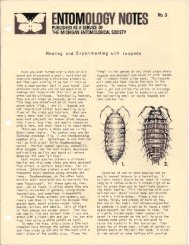
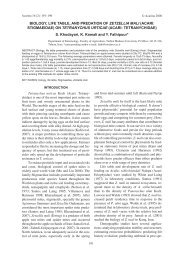
![Williamsonia 1-1 [v4.0] (DR) - Insect Division - University of Michigan](https://img.yumpu.com/18248489/1/190x245/williamsonia-1-1-v40-dr-insect-division-university-of-michigan.jpg?quality=85)
